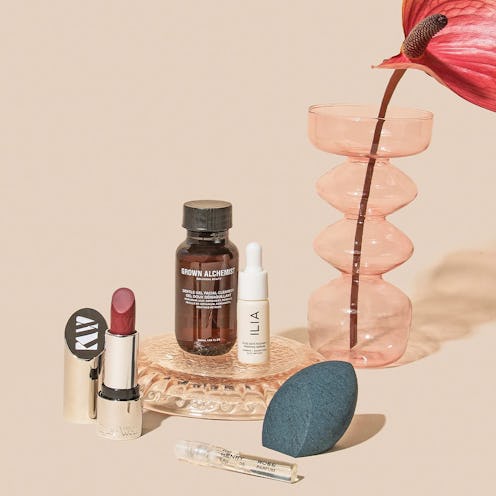What does “clean beauty” really mean? The hard truth is there is no universal definition. As a term that has zero government regulation, the ingredients and sustainability practices of the brands that fall into this corner of the beauty industry can vary vastly. With adjectives like “non-toxic,” “natural,” and “green” being thrown around, it can be overwhelming and downright confusing figuring out what should and shouldn’t be in the products that make up your everyday skin care, hair care, and makeup routines. Not to mention, these descriptors brands love to use often mean nothing at all.
Until more stringent rules are set in place, TZR is being transparent in how we define “clean” in relation to our Eco-Friendly Beauty Heroes. With insight from clean cosmetic chemist and founder of KKT Consultants Krupa Koestline on formulation red flags, our editors’ picks are void of the following ingredients. Furthermore, we’re sharing the sustainability practices we do look out for.
Our Clean Beauty Requirements
Our Eco-Friendly Beauty Heroes do not contain these controversial ingredients.
Benzophenones
Used in personal care products such as nail polish and lip balm to protect the products from UV exposure, benzophenones are a potential endocrine disruptor. Derivatives include benzophenone-2 (BP2) and oxybenzone (benzophenone-3 or BP3).
BHA (Butylated hydroxyanisole) & BHT (Butylated hydroxytoluene)
This common preservative has raised concerns for potentially causing hormone disruption.
Carbon Black
Carbon black is a dark powder used as pigment in eyeshadow, lipstick, and mascara. It’s produced by incomplete combustion of carbon-related products like coal tar and has been linked to cancer. Carbon black also has a negative effect on organ function.
Chemical Sunscreen Filters
UV filters oxybenzone and octinoxate have been linked to hormone disruption and are considered a detrimental threat to marine ecosystems. Octisalate, octocrylene, homosalate, and avobenzone have also been detected on the skin and in the bloodstream weeks after use and in breast milk and urine samples, yet more studies need to be done to determine their full impact.
Coal Tar
This byproduct of coal processing is a known carcinogen.
Cyclic Silicones
Data indicates that cyclic silicones may have reproductive, developmental toxicity, and/or endocrine disruption concerns. They are also persistent in the environment and may build up in the food chain.
Ethanolamines
This family of chemicals work as cleansing agents or surfactants and have been linked to liver cancer.
Formaldehyde & Formaldehyde Donors
A known carcinogen that’s been linked to respiratory issues, among other health concerns. Donor examples: 2-bromo-2-nitropropane-1,3-diol, Diazolidinyl Urea, DMDM Hydantoin, and quaternium-15.
Hydroquinone
This common but controversial skin care ingredient is banned in some countries because it is a potential carcinogen.
Mineral Oil
This byproduct of the petroleum industry is most often used as a moisturizing agent, but it can be harmful to the environment.
Methylisothiazolinone & Methylchloroisothiazolinone
These preservatives are banned from use in leave-on cosmetic products in the EU and are restricted to very small amounts in rinse-off products. They can cause skin allergies and irritation and may be toxic to the nervous system.
Nitromusks & Polycyclic Musks
There are several types of synthetic musks used as fragrance ingredients. Two types, nitromusks and polycyclic musks, have health and environmental concerns ranging from suspected endocrine disruption to widespread environmental persistence.
Parabens
This common preservative may negatively affect hormone and endocrine health.
PEGS & PEG Compounds
PEG is an acronym for polyethylene glycol. While considered safe to use in cosmetics, the process of making these softening and thickening agents includes ethoxylation, which creates 1,4-dioxane as a byproduct — a known carcinogen.
Petrolatum
Also known as petroleum jelly, this skin protectant helps retain moisture, but it’s derived from crude oil. Chemicals in oil called polycyclic aromatic hydrocarbons are known carcinogens but because they are removed during the refining process, they’re not in cosmetics. However, the process of making petroleum jelly is detrimental to the environment.
Phthalates
Believed to be hormone disruptors, phthalates can lead to a number of health issues.
Polyacrylamide
Polyacrylamide can break down into acrylamide, a known carcinogen.
Sodium Lauryl Sulfate or Sodium Laureth Sulfate (SLES/SLS)
These harsh surfactants can strip the skin and be irritants.
Talc
A mineral used in eyeshadows and other powder products to absorb moisture, oil, and prevent caking. Whether or not talc itself is cancerous is still up for debate, but it can be contaminated with asbestos. Research has shown regular exposure to talc can be connected to ovarian, lung, and endometrial cancers.
Toluene
A toxic ingredient that’s widely used in nail polish and permanent hair dyes. It’s been linked to respiratory and reproductive issues, and can also cause temporary side effects such as headaches, dizziness, and cracked skin.
Triclosan & Triclocarban
These chemicals have been shown to disrupt hormone cycles and potentially cause muscle weakness.
Cruelty-Free
None of the Eco-Friendly Beauty Heroes test on animals during any part of the product creation process and they don’t use animal-derived ingredients without cruelty-free certificates.
Eco-Friendly Packaging
Each product’s packaging and shipping materials are made from completely recyclable or partially recycled materials and/or the brand takes strides to reduce environmental waste during the production process.
